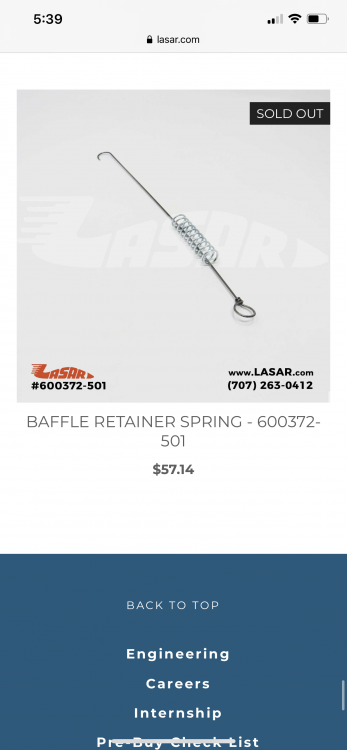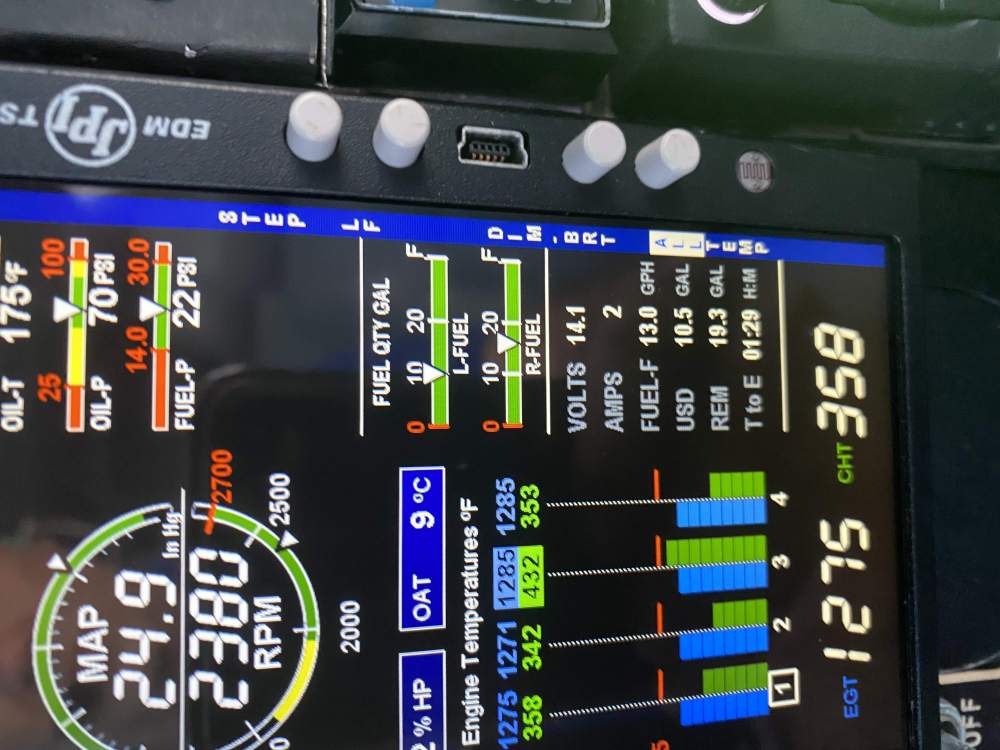-
Posts
519 -
Joined
-
Last visited
-
Days Won
1
Content Type
Profiles
Forums
Blogs
Gallery
Downloads
Events
Store
Everything posted by Brandontwalker
-

CALL FOR OPINIONS: Oxygen Systems
Brandontwalker replied to Brandontwalker's topic in General Mooney Talk
Do you have the MH inline regulator, or are you running it straight from the aircraft o2 supply? Sent from my iPhone using Tapatalk -

CALL FOR OPINIONS: Oxygen Systems
Brandontwalker replied to Brandontwalker's topic in General Mooney Talk
Alright Scott... Let's hear your best sales pitch. -

CALL FOR OPINIONS: Oxygen Systems
Brandontwalker replied to Brandontwalker's topic in General Mooney Talk
I am unsure if my airport has O2, but, like you, I have a refill station in my hangar for the portable system I used in my J for flights in the low teens and night cross country flights. I used Oxysaver cannulas with that system, but am expecting more frequent O2 level flights with the new plane. Frankly, the clutter aspect is what gives me the most pause with a pulse demand system. -

CALL FOR OPINIONS: Oxygen Systems
Brandontwalker replied to Brandontwalker's topic in General Mooney Talk
I absolutely agree. I have two pulse oximeters (one for me and one for passengers). -
I am moving into a turbo Mooney and, for the first time, am assessing options on different oxygen systems. The plane I am purchasing has a built in system with a 115cf tank. What are you guys running? Direct cannulas/masks? Oxysaver cannulas? Pulse Demand (Mountain High O2D2/Precise Flight/Others...)? What about masks? Are you using a standard mask or one with a built in mic (I don't even know how communications would work with a mic-less mask)? I am leaning toward a pulse demand system at present, but I am a bit of a minimalist and want to keep the hoses neat and hidden. Also, I have seen pics of some MH installs and they conflict with my preferred cup holder location :). With that said, let's hear your opinions and show off your install pics! Brandon
-
So… Peter is abandoning all of the original Raptor except the fuselage (kind of). Add a wholly new experimental power set up and you have the Raptor NG. I wish he would have learned from the past and not tried so much at once. We will see how it does. https://raptoraircraft.medium.com/raptor-ng-the-next-generation-cf3e4719b2d3 Sent from my iPhone using Tapatalk
-
I saw this post pop up and completely forget I started it 3 years ago. Sadly, I pulled my deposit on the Raptor sever months ago. Another Mooney is in my near future. Sent from my iPhone using Tapatalk
-

New Interior Panels from Mooney
Brandontwalker replied to Mike A's topic in Modern Mooney Discussion
Hey FF! It has been a while since I checked in. I purchased all materials and obtained the requisite FAA burn certs. I then had a local auto upholstery shop do the work. Unfortunately, they went out of business a couple of years ago. -
So my Mooney was dropped off at the engine shop on Friday. Although compressions were 80/80, we pulled the cylinder and immediately discovered one of the compression rings was shattered and there was a spiral gouge on the cylinder wall. Long post short, cylinder 3 is getting replaced with a factory new assembly from Lycoming. Obviously not the cheapest outcome, but at least it will be fixed and reliable again. I truly appreciate everyone’s input as I am sure you saved me a small mint in troubleshooting costs. Sent from my iPhone using Tapatalk
-
No roughness whatsoever.
-
This weekend was full of more troubleshooting failures. All loose baffling was secured with owner produced parts (safety wire and springs) to see if the issue would be altered. Temps were initially hovering around 400, but I was not surprised as the ambient temperature was in the 80’s and I was running it hard at low altitude. However, a new problem manifested in cylinder 3 in the form of sharply declining egt. CHT reduced with the decline in EGT. The latest log is posted below. I’m done. It is getting checked in to the engine shop tomorrow. I appreciate all of your help. In the event I don’t shoot it like a lame horse, I will post the findings. https://apps.savvyaviation.com/flights/3944915/5a6ed33f-a851-4cad-8a1d-850460430ace
-
Negative. Throttle, mixture, and prop were constant during the spike.
-
According to the IPC, a $57 spring should go here. I could see how a spring may keep the rear baffle from closing when the pressure forces the front baffle open more. Still struggling with the temperature spike though.
-
Another Saturday...another day of testing. Today was spent looking over baffling. The top baffling looks great and there are no signs of light entering when a flashlight is dropped in the oil access. However, the baffling on the bottom is suspect. I have attached a video, but I noted that the baffling on the bottom of cylinder 3 was pulled tight against the fins. Interestingly, the bottom baffling on cylinders 1 and 3 are connected with safety wire. I loosened the safety wire to create a larger gap on cylinder 3 and took a flight. Initially, everything looked good. However, toward the end of the flight, there was a spike in temperature on cylinder 3. The spike in temperature just seems odd to me. Because it hit 435, I pulled cowl flaps half open and was able to cool the cylinder down. In the video you can see that if more air is forced through cylinder 1, cylinder 3 would be pulled closed. Could this be happening in flight? If so, then why only the one spike in temperature? More logs are also attached below. https://apps.savvyaviation.com/flights/3941952/28d82841-961b-4410-8362-f9d4371f3741 IMG_0841.MOV
-
I feel like a knucklehead. I forgot to mention that, I swapped the probe from cylinder 1 to 3 on that flight to test the JPI sensor/harness. Cylinder 1 on the readout is actually cylinder 3...
-
In all of the digging, I have not seen anything loose under the cowl. I assume it is possible, but, for what it is worth, the temperature issue is apparent even with the cowl off completely. I have attached another couple of logs below. The first log was a relatively short flight and you can see the temperature spike at the end. The other is a ground run without the cowl off the airplane. The only reason for the cowl off log is to note how much faster cylinder 3 temp rises than the others. https://apps.savvyaviation.com/flights/3934156/7a33920c-c462-45ea-bb59-ecc9648bd722 https://apps.savvyaviation.com/flights/3934158/b5d96250-4d62-4106-879f-e684285bfcfc
-
After more testing, I am still in the same spot. JPI data from the last flight is below. As for now, I have 3 mechanics from 3 separate shops scratching their heads. It is never easy... https://apps.savvyaviation.com/flights/3934161/18d49b98-c5ea-40f8-81c4-8d87f23d0d1f
-
Thank you. The divider is actually next on the list to open and inspect. Mine is not affected by the SB though.
-
Not sure where my earlier reply went. In flight mag check was done yesterday and is normal.
-
I will pull the JPI data and upload it this weekend. Good suggestion.
-
Forgot to note that the baffling is nearly new and in extremely good condition.
-
Also, run ups are good, but could this somehow be related to the magneto or timing? Nothing has been changed, but it is an item which has not been checked yet.
-
The saga continues. Took it in for a second opinion. Took bonafide compressions. Cylinder 3 (the one overheating) is 80/80. However, you could see some blow by in the form of gasses from the breather tube. He pulled and cleaned the injector for good measure. I cowled it up and went for a ride. The results... the highest temperature I have seen to date on number 3. 432 in level cruise. I am stumped. A recap of what has been done to date: 1) swap cht probe 2) move cht probe with wiring intact to assure there is no issue with the JPI leads 3) change spark plugs 4) clean fuel injector/sleeve 5) clean fuel line from diverted to injector 6) soak cylinder in MMO 7) bore scope (no scratches on walls and valves look good) 8) compression test (80/80). It was 79/80 at last annual At this point, a low compression reading may have been for the best.
-
Oil consumption is up and I am seeing oil from the breather. This seems to confirm a compression issue. Before, I was seeing 11 hours per quart. Now I am at 6-7 hours per quart. Oil changes have routinely been at, or before, 50 hours.
-
No details omitted. Yes, that is part of my hesitation. The other part of hesitation comes from the fact that he indicated the opposing cylinder also needs to be removed to ensure proper torquing of the bolts. I am admittedly uneducated on the subject, but the through case bolts seem to be accessible without removing the opposing cylinder. I am worried about opening more than necessary due to greater risk of maintenance induced failure.






